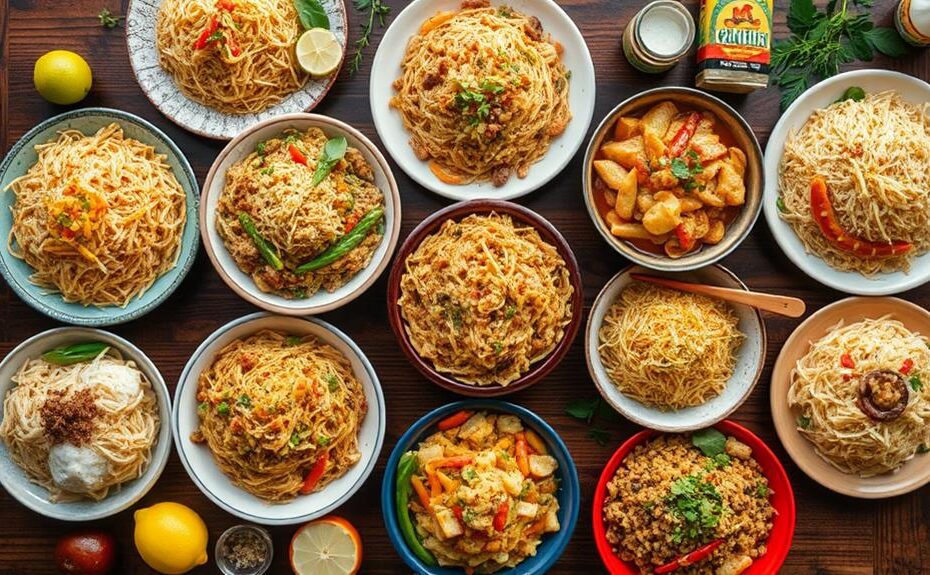Pancit is a diverse Filipino dish with various noodle types, flavors, and regional specialties.
There are several types of noodles used in pancit, each offering a unique texture and taste experience. Bihon noodles are thin, rice flour noodles; canton noodles are thicker, egg-based noodles; miki noodles are round, egg-based noodles; sotanghon noodles are cellophane noodles made from starch and water; and misua noodles are thin, wheat flour noodles.
Some popular pancit dishes include Pancit Bihon, which uses bihon noodles and is often served with vegetables and meat or seafood; Pancit Canton, which uses canton noodles and is often served with vegetables and meat or seafood; and Pancit Malabon, which uses miki noodles and is often served with seafood and a sweet sauce.
These dishes showcase the richness of Filipino cuisine, with regional twists in every corner of the Philippines.
Regional variations of pancit can be found throughout the Philippines, each with its own unique cultural significance, evolution, and ingredients.
Variations of Pancit Noodles
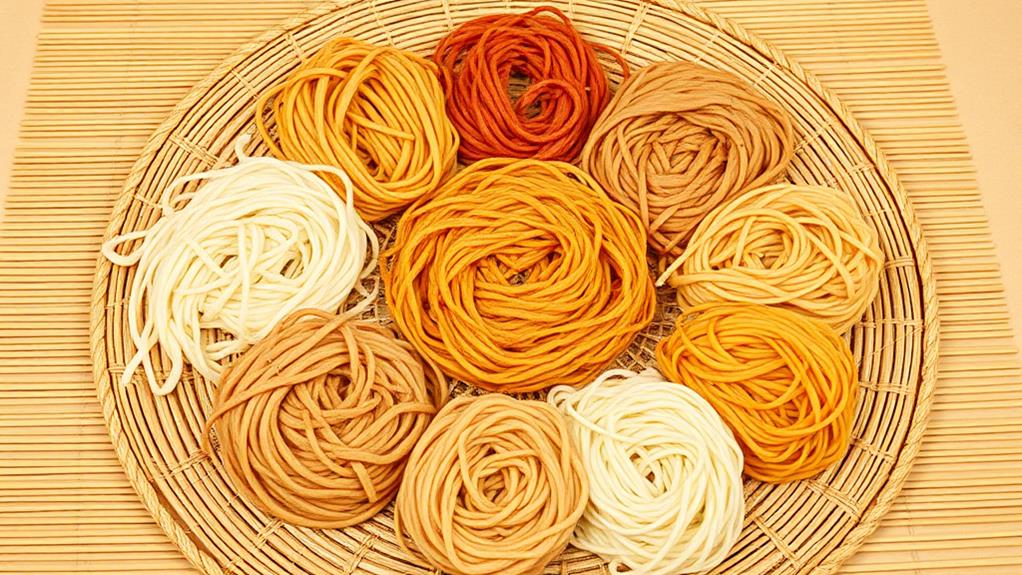
Pancit noodles come in a variety of types, each with distinct textures and flavors.
Bihon noodles, made from rice flour and cornstarch, are ideal for stir-frying and absorbing flavors from sauces. This makes them a great choice for dishes where you want the noodles to take on the flavors of the ingredients.
Canton noodles, made from wheat and eggs, provide a chewier texture. This makes them well-suited for hearty dishes where you want a more substantial bite. Their texture also holds up well to thick sauces and heavy ingredients.
Miki noodles are thick egg noodles available in flat or round shapes. They're commonly used in soups and stir-fried dishes where you want a more substantial bite. Their thickness also allows them to hold onto flavors and ingredients well.
Sotanghon is a type of glass noodle made from mung bean starch. It's often used in soups and is known for its light and delicate texture. This makes it a great choice for dishes where you want a subtle noodle presence.
Misua is an extremely thin wheat noodle. It's typically served in soups and is quick to cook, enhancing the flavor of broths in dishes like almongdigas. Its thinness also allows it to absorb flavors well, making it a great choice for soups and broths.
History of Pancit in Philippines
Pancit originated from Chinese merchants who introduced noodles to the Philippines. The word "pancit" is derived from Hokkien terms for "wonton" and "convenient food." This introduction led to the integration of local ingredients and cooking styles, resulting in unique Filipino adaptations of noodle dishes.
The fusion of Chinese and Filipino cuisines is reflected in these adaptations.
Pancit is traditionally served during significant celebrations like birthdays, symbolizing long life and prosperity. This tradition stems from Chinese customs.
The establishment of panciterias in the Philippines marked the beginning of noodle restaurants, showcasing the growing popularity of pancit in Filipino culinary culture.
There are over 20 distinct varieties of pancit across different regions in the Philippines, each with its own unique flavor profiles and ingredients.
These variations showcase the diversity of Filipino cuisine. Examples include Pancit Bihon, Pancit Lugaw, and Pancit Canton.
The rich cultural heritage and culinary creativity have shaped this beloved Filipino dish.
Must-Try Filipino Pancit Dishes
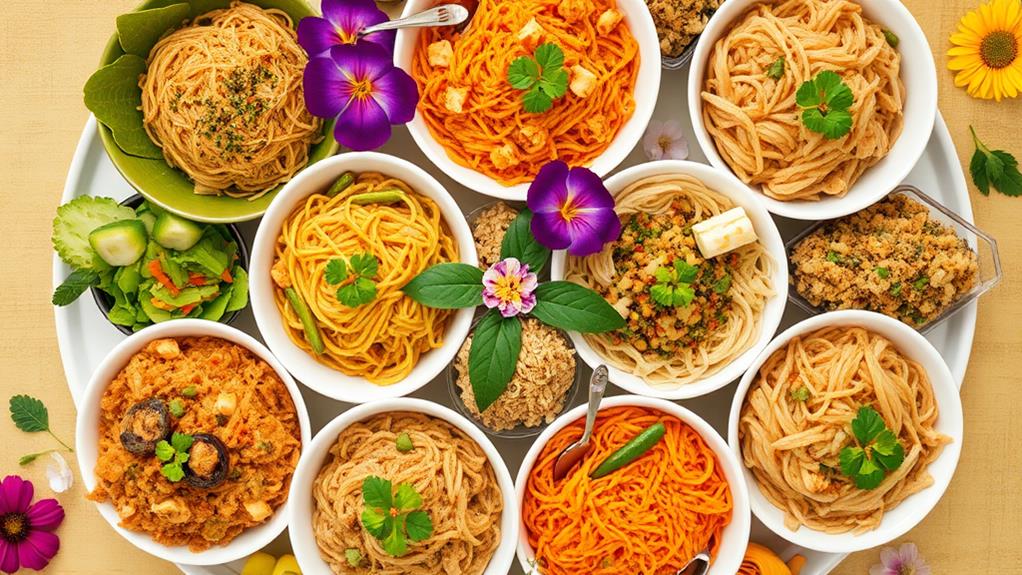
Pancit Bihon: A Popular Filipino Noodle Dish
Pancit Bihon is a staple in Filipino cuisine, made with thin rice noodles stir-fried with vegetables and meats like chicken or shrimp, and flavored with soy sauce and garlic.
This dish is a common sight at celebrations and gatherings.
Variations of Pancit Dishes
Other notable pancit dishes include:
- Pancit Canton, featuring egg noodles stir-fried with meats and vegetables, seasoned with oyster sauce and soy sauce.
- Pancit Malabon, characterized by its thick rice noodles topped with a rich shrimp sauce and seafood.
- Pancit Sotanghon, which uses glass noodles made from mung beans, typically cooked with chicken, mushrooms, and flavored with soy sauce and sesame oil.
Regional Pancit Specialties
Regional Pancit Specialties
Across the Philippines, different regions have their own unique pancit dishes, each reflecting local culture and traditions.
Cebu's Pancit Bam-I
Cebu's Pancit Bam-I is a popular choice during local celebrations.
It combines bihon and canton noodles with various meats and vegetables, making it a distinct flavor profile.
Pancit Batil Patung in Tuguegarao
In Tuguegarao, you'll find Pancit Batil Patung.
It features thicker miki noodles topped with minced carabao meat, a fried or poached egg, and chicharrón.
Pancit Kinalas in Naga City
Naga City's Pancit Kinalas is characterized by its thick sauce and scraped meat, served with egg noodles in a flavorful broth.
Pancit Malabon in Malabon City
Malabon City's Pancit Malabon is known for its thick rice noodles topped with a rich seafood sauce made from shrimp paste.
Pancit Sotanghon
Pancit Sotanghon is made with glass noodles derived from mung beans.
It is often served in a light chicken broth with vegetables.
These regional varieties showcase the diversity of pancit dishes across the Philippines.
Popular Pancit Ingredients
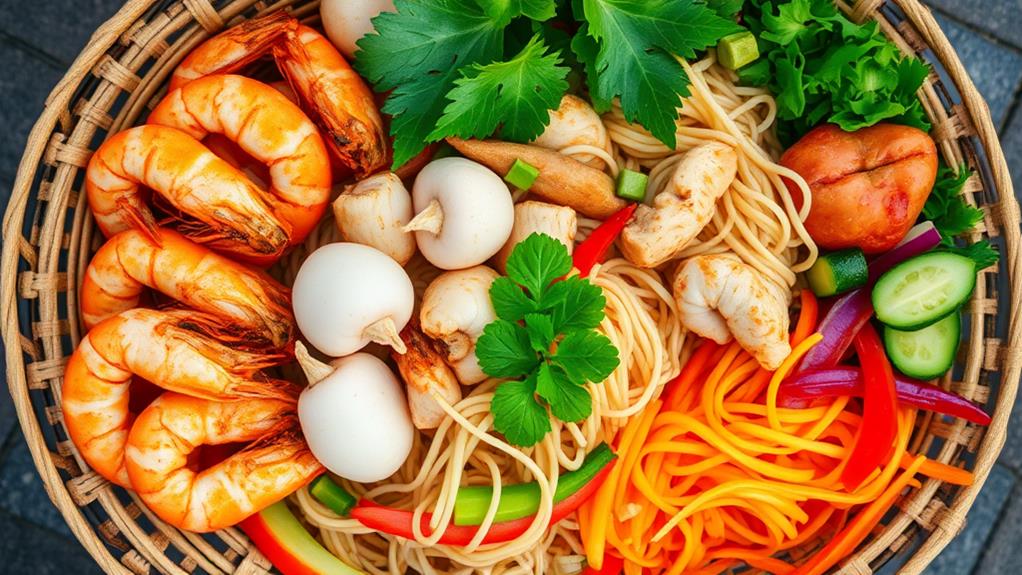
Pancit recipes typically rely on a combination of staple ingredients to create their signature flavors and textures. These ingredients include various types of noodles, such as bihon (rice vermicelli) and canton (egg noodles), which serve as the base of many recipes.
Vegetables are added to provide flavor, nutrients, and crunch. Common vegetables used in pancit recipes include carrots, cabbage, bell peppers, and snow peas.
Meats are used to add heartiness and richness to the dish. Popular proteins used in pancit recipes include chicken, shrimp, pork, and beef.
Seasonings are essential for flavoring and giving pancit its signature taste profile. Common seasonings used include soy sauce, oyster sauce, garlic, and calamansi juice.
Additional toppings are used to add texture and visual appeal to the final dish. These toppings often include hard-boiled eggs, green onions, and chicharrón (crispy pork skin).
Cooking Techniques for Pancit
Mastering Cooking Techniques for Pancit
Stir-Frying: Quick and Crispy
Stir-frying is a cooking technique that rapidly sautés ingredients over high heat in a small amount of oil, enhancing flavors and textures. This method is perfect for pancit dishes that require a crispy texture and caramelized flavors.
For example, stir-frying is ideal for Pancit Canton, where the noodles and vegetables are quickly cooked in a wok to achieve a crunchy texture and a savory flavor.
Braising: Rich and Savory
Braising is a slower cooking method that involves cooking ingredients in a flavorful broth, resulting in a rich and savory dish. This technique is ideal for noodle soups like Pancit Lomi, where the broth is the star of the show.
To achieve the desired flavor and consistency, it's essential to carefully prepare the broth by simmering it for an extended period.
Steaming: Moisture Retention
Steaming is used for certain noodle variations to retain moisture and maintain the integrity of the noodles. This technique is particularly useful for delicate noodles like Pancit Miki, which can become mushy if overcooked.
Presentation: Aesthetics and Flavor
Presentation techniques like serving pancit on banana leaves not only add a local aesthetic but also subtly influence the cooking process by imparting additional flavors.
The banana leaves infuse the noodles with a subtle, slightly sweet flavor that complements the dish.
Cultural Significance of Pancit
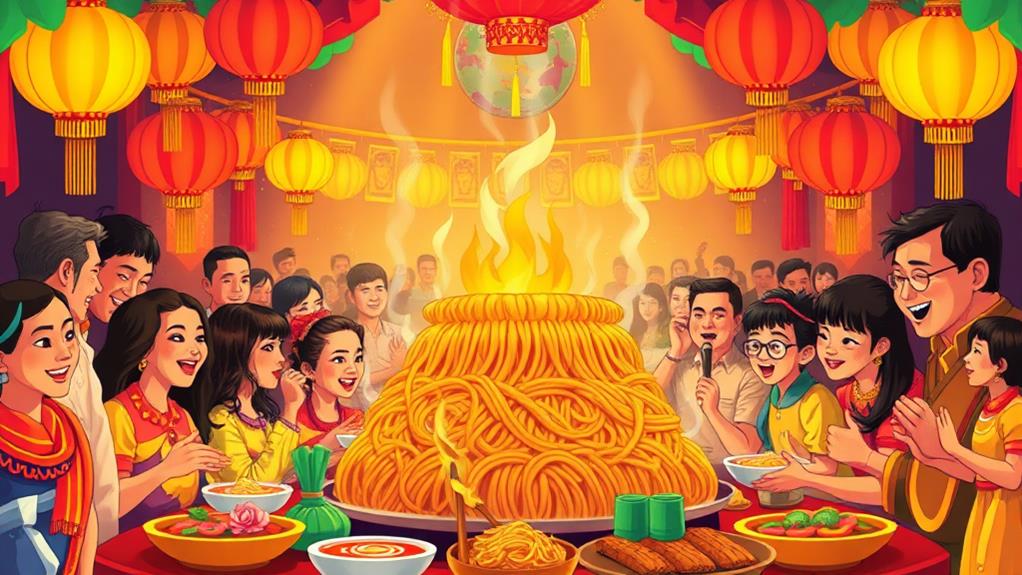
The cultural significance of pancit extends beyond its taste and texture, holding a profound importance in Filipino culture.
Pancit symbolizes long life. In Filipino culture, pancit is traditionally served during birthdays and special celebrations, signifying good fortune and longevity. This tradition stems from the Chinese influence, where noodles represent a long and healthy life.
Pancit represents culinary fusion. The dish combines Chinese and Filipino culinary traditions, showcasing the historical cultural exchange between the two nations. For instance, the use of stir-frying and noodles originated from Chinese cuisine, while the addition of vegetables and spices reflects Filipino flavors.
Pancit fosters community bonding. In Filipino gatherings, pancit is often prepared in large quantities, encouraging communal sharing and social bonding. This tradition reinforces family ties and strengthens social connections.
Pancit embodies cultural pride. The diverse variations of pancit dishes demonstrate the adaptability of Filipino cuisine, incorporating local ingredients and cooking styles into traditional noodle recipes. This creativity and resourcefulness are a source of cultural pride for Filipinos.
Through pancit, the rich cultural heritage of the Filipino community is showcased, where food brings people together and tells a story of cultural exchange and adaptation.
Unique Pancit Noodle Dishes
The Philippines is home to a diverse array of pancit dishes, each with its own unique flavor profile and traditions.
One such dish is Pancit Malabon, which features thick rice noodles and is characterized by its rich seafood toppings, typically including shrimp and squid, and often garnished with hard-boiled eggs and green onions.
Another regional specialty is Pancit Habhab, originating from Quezon, which uses flat rice noodles served on banana leaves and is typically topped with sautéed vegetables and meat. This dish is notable for being eaten without utensils, adding to its rustic charm.
Other unique pancit noodle dishes include Pancit Sotanghon, made from glass noodles derived from mung beans, and Pancit Chami, which utilizes egg noodles stir-fried with a mix of vegetables and meat, characterized by its thick, savory sauce with a hint of vinegar.
Each of these dishes offers a distinct flavor profile that showcases the diversity of pancit in the Philippines.
Pancit in Filipino Celebrations
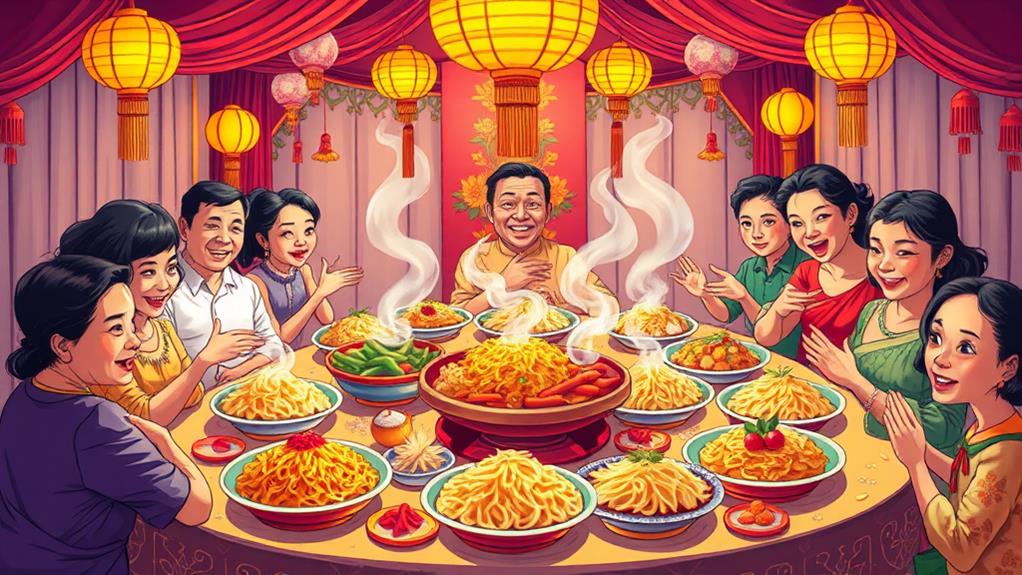
Pancit is an integral part of Filipino celebrations, symbolizing long life and good fortune.
Communal sharing is reflected in the preparation of pancit, which is often made in large quantities to accommodate the Filipino culture of hospitality and togetherness during gatherings. This is evident in the way pancit is served in abundance, ensuring every guest has a share.
Regional flavors are showcased through various types of pancit, such as Pancit Bihon and Pancit Canton, which are featured in festive meals. These different variations highlight the diversity of regional flavors and ingredients.
At holidays and special occasions, pancit is typically accompanied by other dishes, emphasizing its role as a staple dish in Filipino cuisine. This is evident in the way pancit is consistently served alongside other traditional dishes during celebrations.
The preparation of pancit often involves family tradition, with cherished recipes passed down through generations. This makes pancit a significant part of cultural heritage, as family members come together to prepare the dish using time-honored recipes.
Are There Specific Types of Pancit That Are Traditionally Served for Special Occasions?
Yes, there are specific types of pancit for special occasions in Filipino cuisine. Pancit Malabon and Pancit Palabok are commonly served during fiestas, birthdays, and other celebrations. These noodle dishes are often prepared with rich and flavorful seafood toppings, making them perfect for festive gatherings.
Evolution of Pancit Recipes
The Evolution of Pancit Recipes
Incorporating Local Flavors and Techniques
As Chinese traders and immigrants introduced their noodle dishes to the Philippines, pancit recipes began to take shape.
Local ingredients and cooking techniques unique to the islands were gradually incorporated, resulting in over 20 distinct variations of pancit. Each region has its own spin, reflecting local flavors and preferences, such as the use of specific meats or vegetables.
Regional Variations and Family Touches
Traditional recipes have adapted through generations, often including personal family touches that differentiate local versions.
For example, some regions use seafood, while others incorporate vegetables like pechay or bok choy. These variations showcase the dynamic nature of pancit, which remains a beloved staple in Filipino cuisine.
Modern Influences and Fusion Dishes
Modern variations of pancit are influenced by international culinary trends.
Creative reinterpretations, like fusion dishes that blend traditional flavors with contemporary styles, are becoming increasingly popular.
For instance, some modern recipes incorporate seasonal ingredients, responding to changing dietary trends while retaining cultural significance.
Frequently Asked Questions
What Are the Different Types of Pancit?
Pancit is a diverse Filipino noodle dish with various regional variations.
These regional pancit dishes differ in their ingredients and cooking techniques.
Pancit Bihon, for instance, uses thin rice noodles, while Pancit Canton is made with egg noodles. Each variation offers a unique flavorful experience.
Pancit Malabon features thick rice noodles topped with rich seafood sauce, whereas Pancit Habhab is served on banana leaves with flat rice noodles.
What Is the Most Popular Pancit in the Philippines?
Pancit Bihon is the most popular pancit in the Philippines.
This stir-fried rice noodle dish has become an integral part of the country's culinary history.
Regional variations of Pancit Bihon reflect the cultural significance of pancit in different areas.
Its versatility and flavor have made it a staple in many Filipino households, suitable for both festive occasions and everyday meals.
What Is the English Name for Pancit?
Pancit is referred to as "noodles" in English. This name is fitting, given that pancit is a type of noodle dish. It originated from Chinese culinary traditions and got its name from the Hokkien words for "convenient food."
Pancit is typically made with various ingredients such as rice flour or egg.
It's often served at celebrations and gatherings, symbolizing longevity and good fortune.
What Is the Difference Between Pancit Guisado and Pancit?
The main difference between Pancit Guisado and Pancit lies in their ingredients, cooking methods, and regional variations.
Pancit Guisado is a specific stir-fry dish that typically consists of a mix of leftover meats and vegetables. It is a distinct recipe with a set of ingredients and cooking methods.
On the other hand, Pancit is a broader term that encompasses various noodle dishes. These dishes can have different ingredients, cooking methods, and flavor profiles depending on the region.
For example, Pancit Lomi is a soup-based dish, while Pancit Malabon features a rich seafood sauce. The diversity of Pancit recipes is what makes them exciting to explore and discover.
